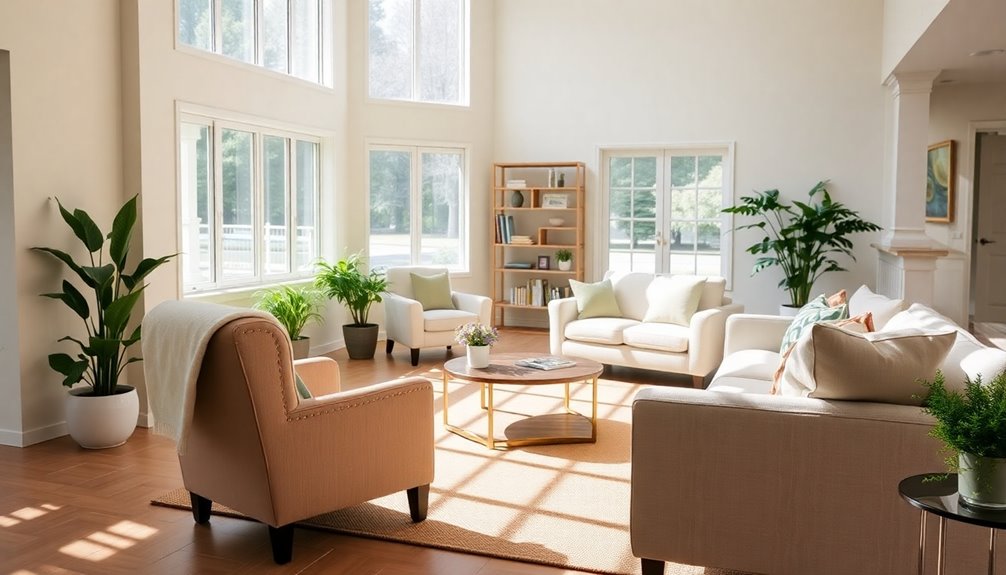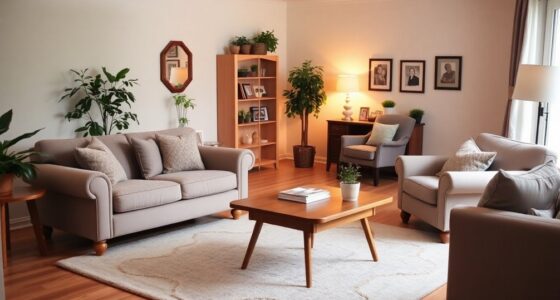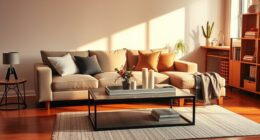To enhance senior living spaces, focus on maximizing natural light and creating open seating arrangements. Use multi-functional furniture to save space and define areas with light-colored rugs. Choose soft wall colors to brighten the environment and strategically place furniture for easy movement. Prioritize comfort and support while personalizing with decor that reflects memories and heritage. Discovering more layout secrets can help you create a safer and more inviting home for older adults.
Key Takeaways
- Arrange furniture in U-shapes to promote conversation and social interaction, enhancing community engagement in senior living spaces.
- Utilize lightweight, multi-functional furniture like lift-top coffee tables to maximize space and provide versatility for various activities.
- Keep pathways clear with at least 36 inches of space for easy navigation, ensuring safety and mobility for residents.
- Use light-colored rugs to create the illusion of spaciousness while improving safety with non-slip backing.
- Personalize spaces with family photos and cultural decorations to foster emotional connections and a sense of belonging for seniors.
Maximize Natural Light

To create a warm and inviting atmosphere in senior living spaces, maximizing natural light is key.
Start by positioning your furniture away from windows to let natural light flow freely, enhancing the brightness of the room.
Opt for lightweight, sheer window treatments that maintain privacy while allowing sunlight to stream in. Incorporating open layouts can also enhance the flow of light throughout the space. Regular exposure to natural light can promote better sleep quality, which is particularly beneficial for seniors.
Consider incorporating mirrors opposite windows; they reflect natural light, visually expanding your space and brightening darker areas.
Choosing light colors for walls and furniture finishes can help bounce light around, further illuminating the room.
Finally, keep window areas clear of obstructions to promote an open and airy feel. Additionally, introducing large indoor plants can improve air quality and contribute to a serene environment.
Create Open Seating Arrangements
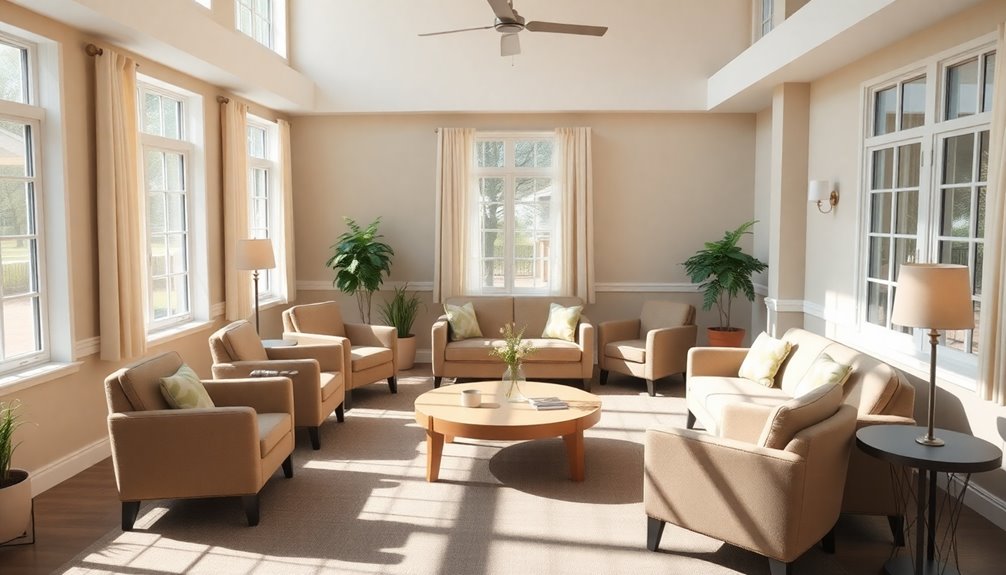
Creating open seating arrangements not only enhances the flow of a room but also makes it easier for seniors to navigate their living spaces safely. This is particularly important for those facing mobility challenges.
By adopting an accessible layout, you can facilitate movement and foster social interaction among residents. Consider these key elements:
- Arrange furniture in circular or U-shapes to encourage conversation.
- Keep furniture away from walls to improve traffic flow and reduce fall risks.
- Use lightweight, movable furniture for flexible arrangements.
- Maximize natural light by allowing it to flow freely through the space.
Incorporating emotional intelligence into the design can further enhance the atmosphere, creating a space that feels more supportive and connected.
With these strategies, you'll create a welcoming environment that promotes safety and enhances the overall ambiance for seniors.
Utilize Multi-functional Furniture
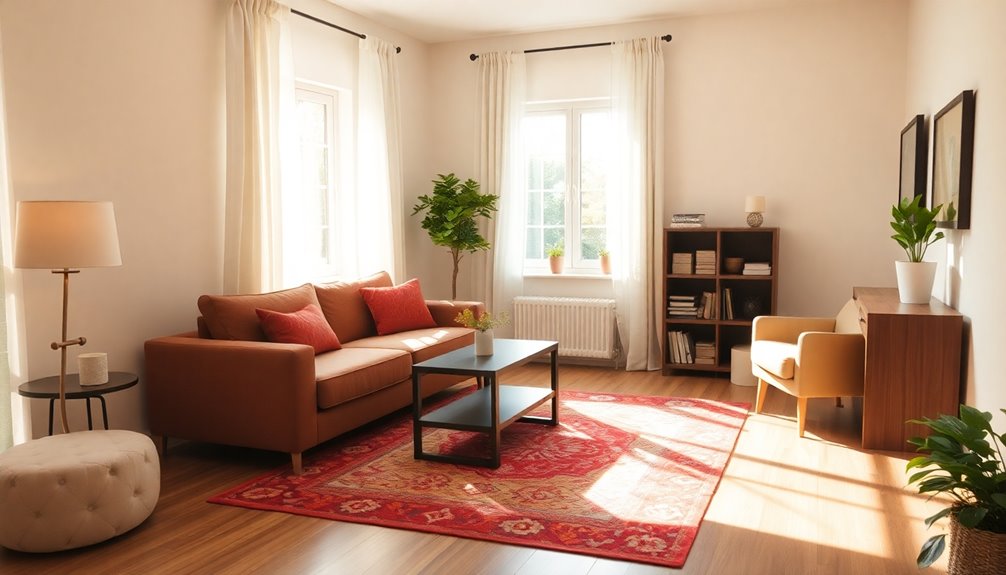
When you're designing a senior living space, utilizing multi-functional furniture can greatly enhance both functionality and comfort. Pieces like lift-top coffee tables or sofa beds maximize space by serving more than one purpose, making them perfect for smaller environments. Consider ottomans with hidden storage that provide extra seating while keeping essentials organized and out of sight, promoting a tidy living area. Additionally, integrated grinders in espresso machines can be a valuable addition for those who enjoy fresh coffee, enhancing daily routines. Adjustable-height tables can shift from dining to desk use, enhancing the flexibility of your living space. Moreover, choosing furniture that promotes social interaction can encourage communal activities, which is vital for emotional well-being. Nesting tables are also ideal, as they can be easily moved and stored, offering additional surface area without permanent clutter. Investing in modular furniture guarantees customizable arrangements that adapt to changing needs, enhancing comfort underfoot and usability over time. Additionally, seeking professional counseling can provide emotional support, which is crucial during transitions to new living arrangements.
Define Spaces With Area Rugs
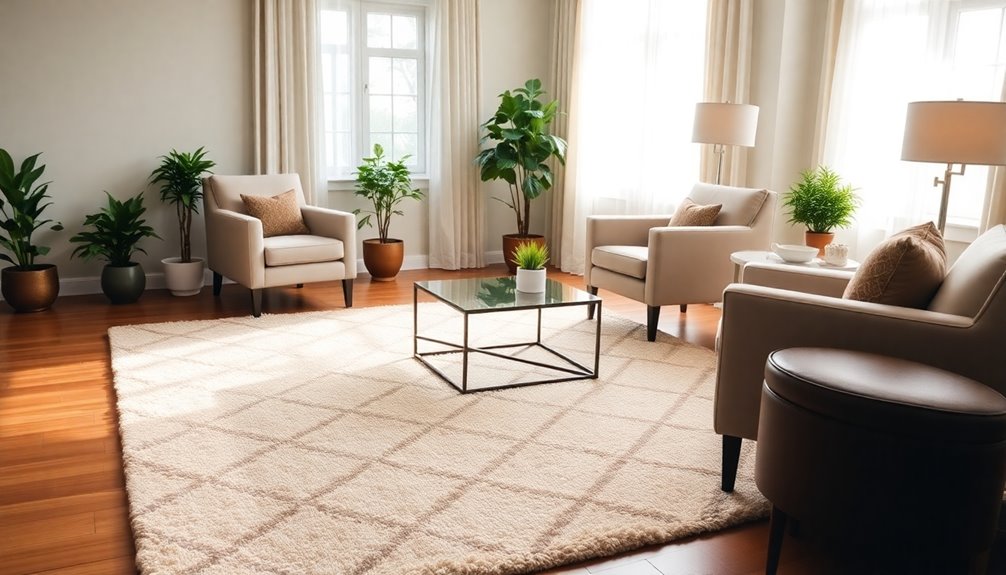
Multi-functional furniture sets the stage for a well-organized living space, but defining areas with area rugs takes it a step further.
By using area rugs, you can visually delineate different functional spaces, enhancing organization and flow in senior living environments.
Here are some tips to bear in mind:
- Choose light-colored rugs to reflect light and create a spacious illusion.
- Opt for low pile, non-slip backing rugs for safety and comfort.
- Coordinate area rugs with your room's color scheme to create a cohesive look.
- Use rugs as focal points to enhance the aesthetic appeal of your space.
These strategies not only define spaces but also contribute to a warm, inviting atmosphere that's essential for senior living.
Choose Light Colors for Walls

Choosing light colors for walls can profoundly transform a senior living space, as these shades reflect natural light and make rooms feel larger and more open.
Soft neutrals like beige, cream, or light gray not only create a comfortable environment but also promote a calming atmosphere that enhances overall well-being. Such colors evoke feelings of peace and happiness, which are essential for fostering a soothing setting for seniors.
You can easily incorporate pops of color through accessories against these light-colored walls, adding visual interest without overwhelming the space.
Ultimately, selecting light colors has a major impact on the room's mood, contributing to a positive living experience that supports both comfort and tranquility in senior living.
Incorporate Mirrors for Depth
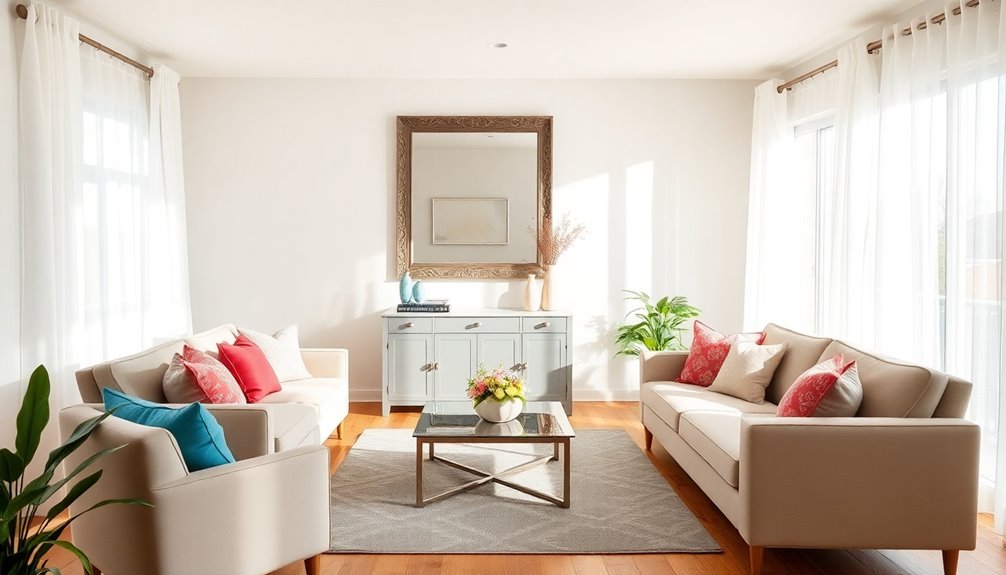
Incorporating mirrors in your senior living space can truly transform the atmosphere.
By placing them opposite windows, you'll reflect natural light and create a brighter, more inviting environment.
Plus, mirrors add visual interest and elegance, making your home feel more spacious and stylish.
Reflect Natural Light
While enhancing the ambiance in senior living spaces, mirrors can play an essential role in reflecting natural light, instantly brightening up a room.
By strategically placing mirrors opposite windows, you can effectively double the light in the space, making it feel larger and more inviting. This not only enhances mood but also creates an illusion of depth, particularly beneficial in smaller areas. Incorporating essential oils for respiratory health can also contribute to a fresher atmosphere, enhancing overall well-being.
- Use decorative mirrors as focal points.
- Opt for mirrors with anti-glare coatings.
- Position mirrors to maximize daylight.
- Confirm mirrors aid in mobility and navigation.
Incorporating these elements helps create a warm, welcoming environment, allowing seniors to enjoy a more open and cheerful living space. Additionally, air purifiers with HEPA filtration can further improve air quality, contributing to a healthier living environment.
Create Visual Interest
To create visual interest in senior living spaces, mirrors can be your best ally, transforming mundane areas into vibrant environments. By positioning mirrors opposite windows, you'll reflect natural light, brightening the space. This not only creates a cozy atmosphere but also visually doubles the perceived size of the room. Additionally, incorporating necessary cookies can enhance user experience on websites related to furnishing ideas.
Moreover, well-designed spaces can significantly contribute to enhanced quality of life, making it easier for seniors to navigate and enjoy their surroundings. You can add personality by choosing mirrors with unique frames that complement your decor. Consider using strategically placed mirrors as decorative focal points, adding flair while serving practical purposes like self-checks.
For an engaging touch, arrange multiple smaller mirrors to form a gallery wall, inviting conversation and interaction among residents and visitors. This simple addition can elevate the overall ambiance while promoting a sense of community. Additionally, incorporating AI design principles can further enhance the functionality and aesthetic appeal of these living spaces.
Strategic Furniture Placement
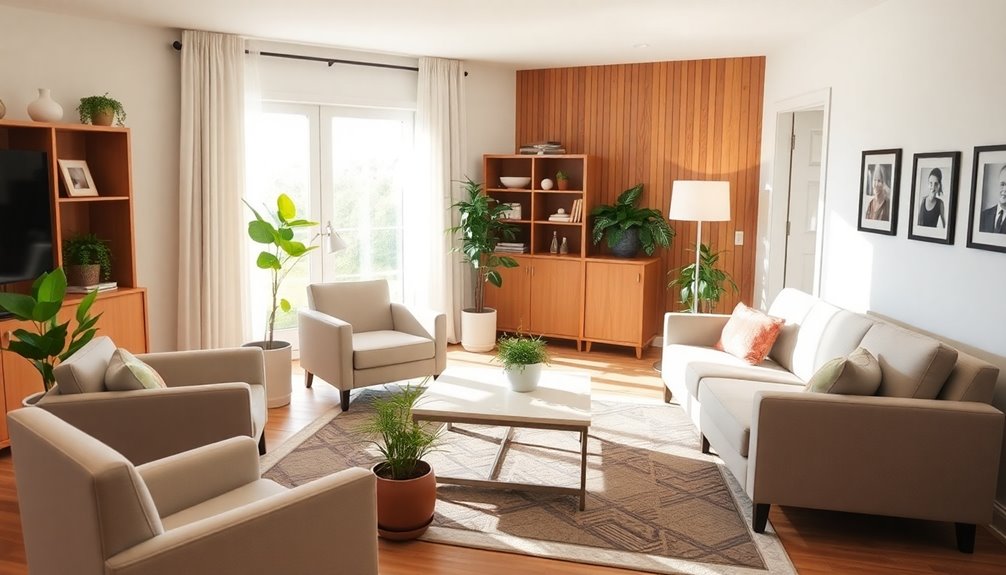
When you think about furniture placement, consider how it impacts flow and accessibility in your space.
By defining distinct living areas and enhancing social interaction spaces, you create an environment that feels both functional and inviting.
Prioritizing these elements makes a significant difference in the comfort and wellbeing of senior residents.
Optimize Flow and Accessibility
Creating a welcoming environment in senior living spaces means prioritizing flow and accessibility through strategic furniture placement.
To optimize the layout, consider these key strategies:
- Create clear pathways that accommodate mobility aids, ensuring at least 36 inches of space for easy navigation.
- Opt for light, low-profile furniture to minimize visual clutter and enhance the sense of openness.
- Position seating away from walls to promote better traffic flow and encourage social interaction among residents.
- Use round tables instead of square ones to facilitate movement and reduce sharp corners in dining areas.
Define Distinct Living Areas
Distinct living areas enhance the functionality and aesthetic appeal of senior living spaces. To define these areas, strategically place furniture that creates visual boundaries. For instance, position a sofa to separate the living room from the dining area.
Incorporate area rugs to delineate zones, like using one under a coffee table for a cozy seating area. Multifunctional furniture, such as storage ottomans, can maximize space while acting as visual dividers. Additionally, consider natural materials like wood and stone to bring an organic touch to the space. Innovative design choices can also help in effectively defining these areas and improving overall comfort.
Arrange seating in a circular formation to promote conversation and distinctly mark social spaces. Additionally, consider taller furniture like bookshelves or plant stands to create vertical separation without blocking light, ensuring your living space feels open and inviting. Incorporate textures like metal, wood, and fabrics to enhance the warmth and character of each distinct area.
Enhance Social Interaction Spaces
- Arrange seating in circular or semi-circular layouts to encourage conversation.
- Position furniture to create clear pathways, ensuring easy movement for seniors.
- Use low-profile furniture pieces to maintain unobstructed sightlines for better engagement.
- Incorporate multi-functional items, like ottomans that double as storage.
Additionally, integrating natural elements into the space can enhance the overall ambiance, promoting a calming atmosphere conducive to socializing.
Optimize Traffic Flow
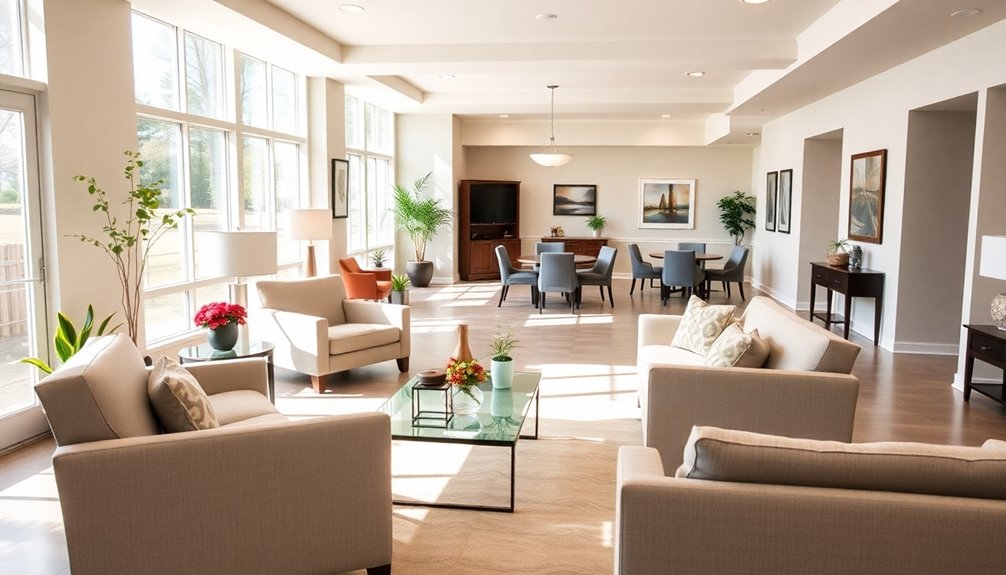
To guarantee residents can navigate their living space comfortably, it's essential to arrange furniture in a way that promotes clear pathways. Aim for pathways at least 36 inches wide to guarantee easy navigation, especially for those using mobility aids. Position larger furniture pieces away from walls to facilitate an open flow and enhance social interaction. Use rugs with non-slip backing to define spaces and guide movement, while also guaranteeing safety. Opt for low-profile furniture to maintain sightlines and create a sense of openness. Regularly reassess furniture arrangements to adapt to changing mobility needs, keeping traffic flow unobstructed and functional.
| Tip | Description | Benefit |
|---|---|---|
| Create Clear Pathways | Guarantee 36-inch wide paths | Easy navigation |
| Position Furniture | Keep larger items away from walls | Unobstructed traffic flow |
| Use Non-Slip Rugs | Define spaces safely | Prevent trips and falls |
Emphasize Comfort and Support

Creating a comfortable living space is essential for promoting the well-being of seniors, especially when you focus on seating options that offer support.
Prioritize features that enhance comfort and accessibility to create a safer living environment. Consider these elements:
- Comfortable seating options with lumbar support and padded armrests
- Multi-functional furniture like lift-top coffee tables for storage and ease
- Adjustable height features for personalized comfort
- Ottomans or footrests to elevate feet and improve circulation
Personalize With Decor and Keepsakes

Once you've guaranteed comfort and support in the living space, adding personal touches through decor and keepsakes can greatly enhance the atmosphere. Incorporating personal memorabilia, like family photos and cherished keepsakes, fosters emotional connections. A dedicated memory wall can showcase achievements, reinforcing a sense of belonging.
| Decorating Ideas | Sentimental Value | Cultural Elements |
|---|---|---|
| Family photo displays | Cherished keepsakes | Traditional artwork |
| Memory wall creation | Celebrating milestones | Textiles reflecting heritage |
| Rotating decor items | Evoking memories | Personal interests |
| Coordinated frames | Enhancing visual appeal | Cultural decorations |
| Engaging experiences | Fostering connections | Personal stories |
These personal touches can make all the difference in memory care environments.
Frequently Asked Questions
How to Design a Room for the Elderly?
When you're designing a room for the elderly, prioritize comfort and accessibility. Choose supportive seating with lumbar support, and arrange furniture to create clear pathways, reducing fall risks.
Incorporate multi-functional pieces for storage and keep the space clutter-free. Use light colors to enhance natural light and improve mood.
Finally, consider adjustable height furniture to cater to different mobility needs, ensuring that the space feels personalized and inviting for its users.
What Not to Bring to Assisted Living?
They say, "Less is more," especially when moving to assisted living.
You shouldn't bring oversized furniture that clutters your space or restricts movement. Avoid personal items that create clutter and make things chaotic.
Large appliances and heavy exercise equipment aren't allowed, either.
Finally, steer clear of items that could pose safety risks, like sharp-edged furniture or area rugs without non-slip backing.
Keeping it simple guarantees a comfortable and safe living environment.
How to Furnish a Senior Apartment?
When you're furnishing a senior apartment, prioritize multi-functional furniture that saves space and enhances usability.
Think about comfortable seating with good lumbar support, and guarantee pathways are clear for easy navigation.
Choose low-profile pieces to create an open feel and keep larger items away from walls for better traffic flow.
Incorporating storage solutions within furniture can help maintain organization, making daily living more enjoyable and accessible for you or your loved one.
How to Make Room Look Bigger With Furniture?
To make your room look bigger with furniture, you'll want to choose low-profile pieces that create an open feel.
Arrange furniture away from the walls to improve traffic flow and accessibility.
Opt for multi-functional items, like storage ottomans, to maximize utility without adding clutter.
Incorporate mirrors to reflect light and enhance depth, and select furniture with exposed legs to visually lighten the space.
These tips will help you create a more spacious atmosphere.
Conclusion
By applying these ten furniture layout secrets, you can transform senior living spaces into inviting havens. Think of your space as a well-tended garden, where each piece of furniture blooms in harmony with the others. Maximize natural light, embrace comfort, and personalize with cherished decor to create an atmosphere that feels just right. With thoughtful arrangement, you’ll cultivate a home that nurtures both independence and connection, making every moment more enjoyable for everyone involved. Incorporating elements like multi-functional furniture can further enhance the usability of the space, making it easier for seniors to navigate their environment. The impact of furniture hacks on seniors extends beyond aesthetics; it facilitates mobility and fosters a sense of autonomy, allowing them to feel empowered in their own home. By integrating these thoughtful strategies, you not only improve the overall design but also promote a sense of community and well-being among residents.
